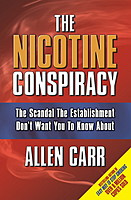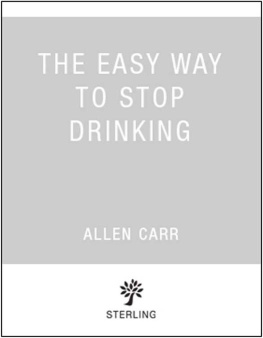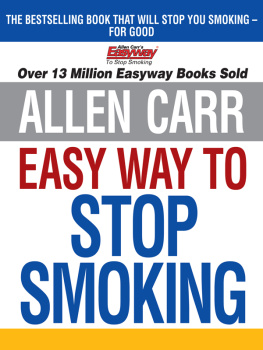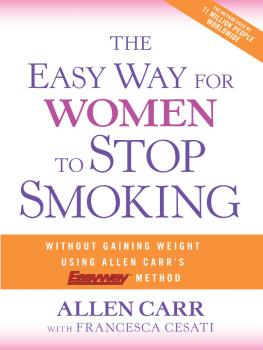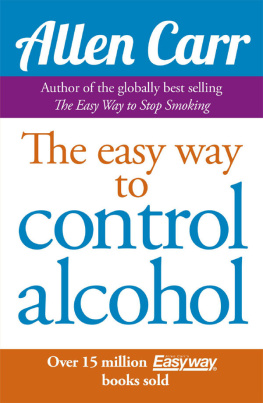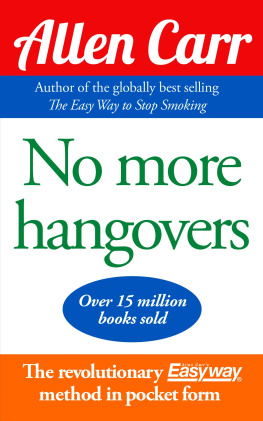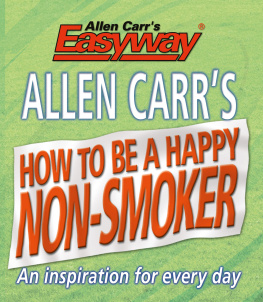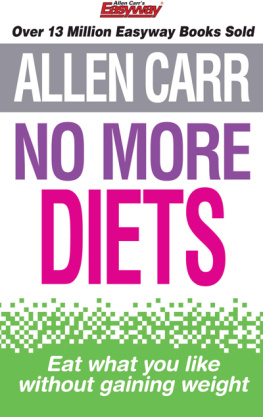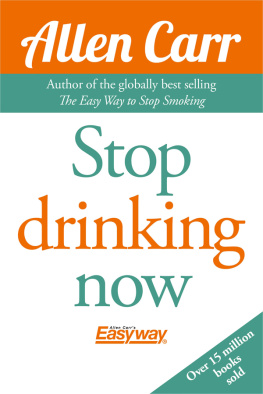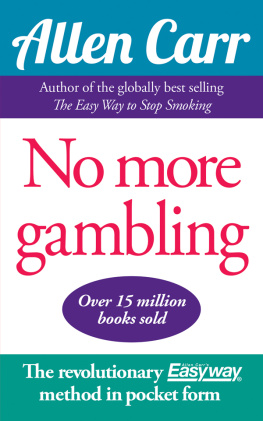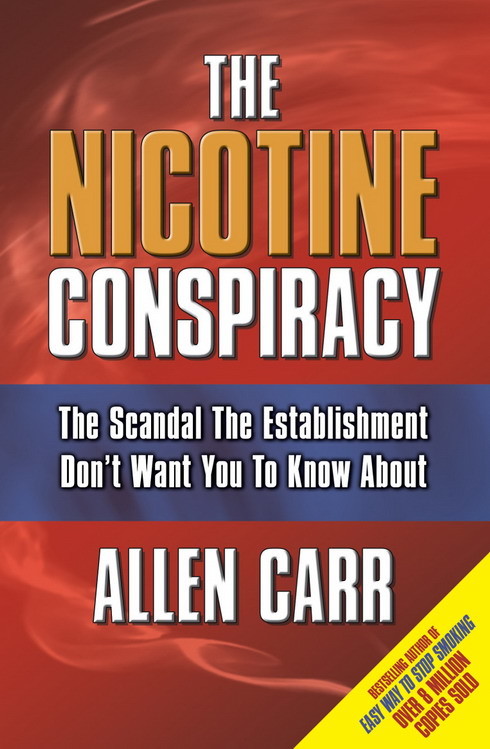
DEDICATION
In no book could the dedication be more appropriate than this:
To Robin Hayley, my friend, colleague and successor.And to his worldwide team of dedicated therapists who, without exception, sacrificed highly paid and successful careers to join our cause.
THE
NICOTINE
CONSPIRACY
ALLEN CARR


Arcturus Publishing Limited26/27 Bickels Yard, 151153 Bermondsey Street,London SE1 3HA Copyright 2011 Allen Carrs Easyway (International) Limited All rights reserved. No part of this publication may be reproduced,stored in a retrieval system, or transmitted, in any form or by anymeans, electronic, mechanical, photocopying, recording or otherwise,without written permission in accordance with the provisionsof the Copyright Act 1956 (as amended). Any personor persons who do any unauthorised act in relation to this publication maybe liable to criminal prosecution and civil claims for damages. ISBN: 978-1-84837-938-1
CONTENTSINTRODUCTIONHitting Ones Head Against a Brick Wall
PART 1 DEVASTATIONCHAPTER 1: The Greatest Scandal Never Exposed
CHAPTER 2: The Objectives of This Book
CHAPTER 3: Devastation
CHAPTER 4: The Way Smoking Devastated My Life
PART 2 EXALTATIONCHAPTER 5: Exaltation
CHAPTER 6: The Nicotine Trap
CHAPTER 7: The Close Association Between Craving Nicotine and Hunger
CHAPTER 8: All Was Revealed!
CHAPTER 9: A Brief Synopsis of Easyway
CHAPTER 10: ILLUSION Smokers Smoke Because They Choose To
CHAPTER 11: ILLUSION The Big 3 Attempt to Help Smokers to Quit
CHAPTER 12: Easyway Versus The Big 3
PART 3 FRUSTRATIONCHAPTER 13: How Easyway Reverses the Difficulties of Quitting
CHAPTER 14: What Are We Trying to Achieve?
CHAPTER 15: ILLUSION Just One Cigarette Wont Hook You
CHAPTER 16: ILLUSION Smoking is a Habit
CHAPTER 17: ILLUSION Smoking Relieves Boredom
CHAPTER 18: ILLUSION Smoking Assists Concentration
CHAPTER 19: ILLUSION Smoking Helps You Relax
CHAPTER 20: ILLUSION A Cigarette is My Friend, My Comfort, My Companion
CHAPTER 21: Clinical Trials and Success Rates
CHAPTER 22: Welcome to the Medicine Business
CHAPTER 23: The Economics
CHAPTER 24: The
Richard & Judy Show
CHAPTER 25: Why The Big 3 Have Failed to Solve the Drugs Problem
CHAPTER 26: Easyway Will Work for Any Smoker
CHAPTER 27: The Insidious Giant Octopus!
CHAPTER 28: The Brainwashing that Creates the Need for Drugs
CHAPTER 29: The Mind-Opening Process that Followed My Escape
CHAPTER 30: The Incredible Machine
CHAPTER 31: The Majority is Always Wrong
CHAPTER 32: Heroin Addiction
CHAPTER 33: Please Help Me End This Scandal
FINAL TRIBUTEREFERENCESCLINIC LISTVOUCHERINTRODUCTION
HITTING ONES HEAD AGAINST A BRICK WALL
Since Allen Carrs death in November 2006, his determination to rid the world of nicotine addiction lives on in the worldwide organization he created and the people he trained. Our tireless efforts at ALLEN CARRS EASYWAY to comprehend and overcome the maze of red tape that stops our method being used by the NHS are testament to that fact.
The body that decides if the NHS will use a particular drug or treatment is the National Institute for Health and Clinical Excellence (NICE). We totally understand why there should be a system for deciding if public money is well spent. We applaud it. What we find so deeply frustrating is that this system makes it almost impossible for companies like ours to understand the rules which apply.
Moreover, even if you can fathom how the system works, you discover that you need to spend literally hundreds of thousands of pounds simply to comply with it. You might think, as we did, that with patient choice being such a central plank of government policy, anything that gives patients more choice might be welcomed. We were wrong and not only about this. Every step of our journey to make ALLEN CARRS EASYWAY accessible to the public via the NHS has been met with brick wall after brick wall. You would think we were peddling poison rather than providing a safe method to cure nicotine addiction.
We have written repeatedly to people high and low in the NHS and Department of Health (DoH), inviting them to investigate our method. We always get the same response, which is that national policy on smoking needs to focus on accumulated evidence around efficacy and implementation. To you and me, that means any method needs to be able to show that it works.
Fair enough, although we fail to understand, if this is the case, why the NHS endorses the use of nicotine-replacement therapy (NRT) and drugs such as Zyban and Champix when the evidence supporting these is vastly inferior to that supporting our method.
You might think, again as we did, that scientists are impartial and that the aim of science is nothing other than to get to the truth. Neither of these things are true, as we discovered.
This chapter in our learning curve began back in November 2004 when we applied to be formally assessed by NICE. We went on to present results from two independent studies, both conducted by scientists at the Institute of Environmental Health at the University of Vienna. These established a success rate of more than 50 per cent for our method after one year. This far exceeds anything obtained by either NRT, Zyban or Champix. In addition to this, we have been operating for more than 20 years, have sold more than 10 million stop-smoking books and have a network of successful stop-smoking clinics in 40 countries. We were sure that with such great results, someone would take us seriously.
But in January 2005 we learned this was not to be. NICE assured us that the minutes of the meeting at which the decision was taken not even to evaluate our method would be made available to us. But when we requested them, we were refused. When we were finally forced to make a Freedom of Information request for a copy of the minutes, it was turned down on the basis of commercial interests, with no further explanation. However, NICE did confirm that the decision not to evaluate was taken by a panel which included representatives of the pharmaceutical industry.
When a new public health progamme on smoking cessation was being planned, this time looking at smoking cessation in the workplace (where the independent studies relating to our method had been set), we registered as a stakeholder in the process. This meant the studies that had been conducted on our method by respected scientists and published in peer review journals had at least to be acknowledged or a reason given.
That was in October 2005. Imagine our shock when, in February 2007, NICE produced its report on a mountain of evidence on various smoking-cessation methods specifically designed for the workplace. Ours, including one published in the
Next page
